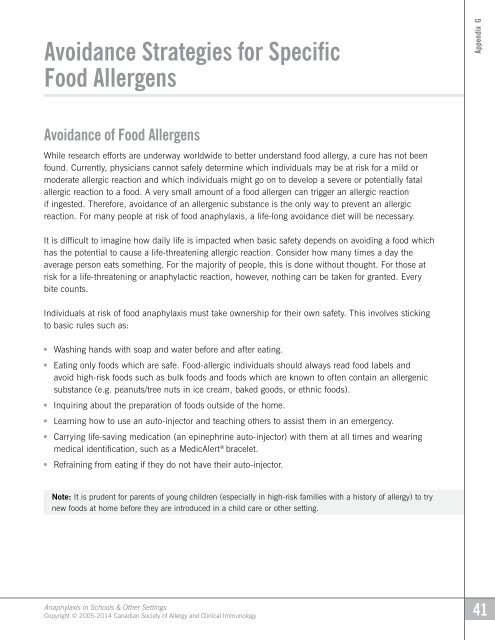Anaphylaxis in Schools 3rd Edition
Anaphylaxis in Schools 3rd Edition
Anaphylaxis in Schools 3rd Edition
You also want an ePaper? Increase the reach of your titles
YUMPU automatically turns print PDFs into web optimized ePapers that Google loves.
Avoidance Strategies for Specific<br />
Food Allergens<br />
Appendix G<br />
Avoidance of Food Allergens<br />
While research efforts are underway worldwide to better understand food allergy, a cure has not been<br />
found. Currently, physicians cannot safely determ<strong>in</strong>e which <strong>in</strong>dividuals may be at risk for a mild or<br />
moderate allergic reaction and which <strong>in</strong>dividuals might go on to develop a severe or potentially fatal<br />
allergic reaction to a food. A very small amount of a food allergen can trigger an allergic reaction<br />
if <strong>in</strong>gested. Therefore, avoidance of an allergenic substance is the only way to prevent an allergic<br />
reaction. For many people at risk of food anaphylaxis, a life-long avoidance diet will be necessary.<br />
It is difficult to imag<strong>in</strong>e how daily life is impacted when basic safety depends on avoid<strong>in</strong>g a food which<br />
has the potential to cause a life-threaten<strong>in</strong>g allergic reaction. Consider how many times a day the<br />
average person eats someth<strong>in</strong>g. For the majority of people, this is done without thought. For those at<br />
risk for a life-threaten<strong>in</strong>g or anaphylactic reaction, however, noth<strong>in</strong>g can be taken for granted. Every<br />
bite counts.<br />
Individuals at risk of food anaphylaxis must take ownership for their own safety. This <strong>in</strong>volves stick<strong>in</strong>g<br />
to basic rules such as:<br />
• Wash<strong>in</strong>g hands with soap and water before and after eat<strong>in</strong>g.<br />
• Eat<strong>in</strong>g only foods which are safe. Food-allergic <strong>in</strong>dividuals should always read food labels and<br />
avoid high-risk foods such as bulk foods and foods which are known to often conta<strong>in</strong> an allergenic<br />
substance (e.g. peanuts/tree nuts <strong>in</strong> ice cream, baked goods, or ethnic foods).<br />
• Inquir<strong>in</strong>g about the preparation of foods outside of the home.<br />
• Learn<strong>in</strong>g how to use an auto-<strong>in</strong>jector and teach<strong>in</strong>g others to assist them <strong>in</strong> an emergency.<br />
• Carry<strong>in</strong>g life-sav<strong>in</strong>g medication (an ep<strong>in</strong>ephr<strong>in</strong>e auto-<strong>in</strong>jector) with them at all times and wear<strong>in</strong>g<br />
medical identification, such as a MedicAlert ® bracelet.<br />
• Refra<strong>in</strong><strong>in</strong>g from eat<strong>in</strong>g if they do not have their auto-<strong>in</strong>jector.<br />
Note: It is prudent for parents of young children (especially <strong>in</strong> high-risk families with a history of allergy) to try<br />
new foods at home before they are <strong>in</strong>troduced <strong>in</strong> a child care or other sett<strong>in</strong>g.<br />
<strong>Anaphylaxis</strong> <strong>in</strong> <strong>Schools</strong> & Other Sett<strong>in</strong>gs<br />
Copyright © 2005-2014 Canadian Society of Allergy and Cl<strong>in</strong>ical Immunology<br />
41


